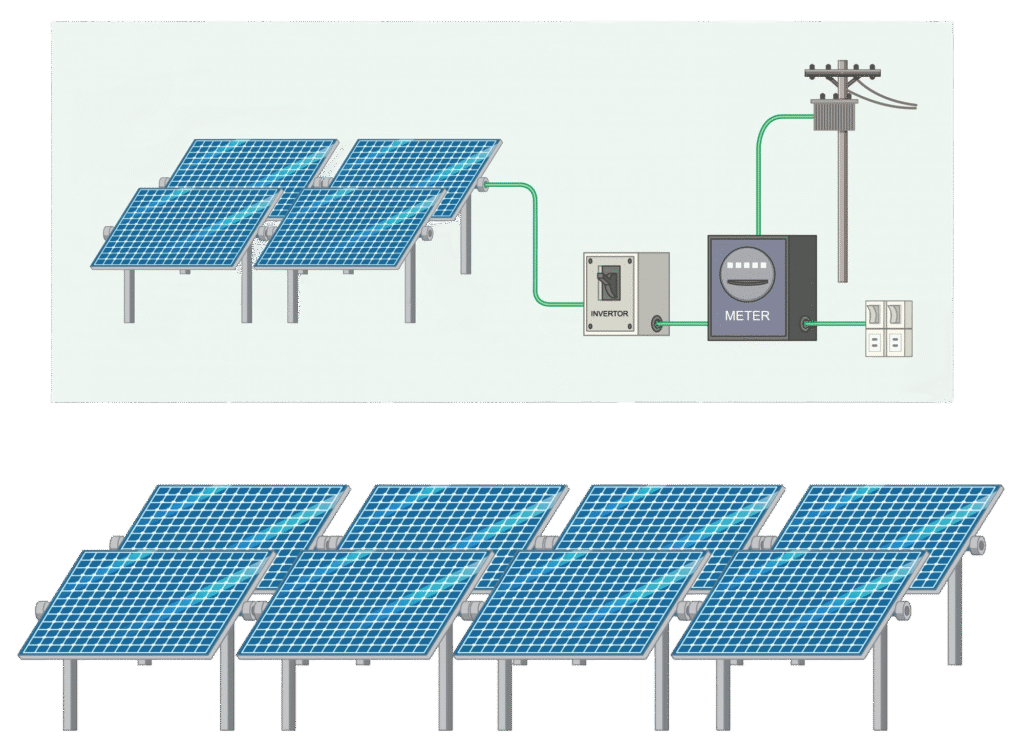

اپنے گھر یا کاروبار کے لیے شمسی توانائی کے اختیارات پر غور کرتے وقت، دو نمایاں طریقے سامنے آتے ہیں: گرڈ سے منسلک اور آف گرڈ سولر سسٹم۔ ہر ایک کے اپنے منفرد فوائد اور نقصانات ہیں، خاص طور پر نیٹ میٹرنگ اور بیٹری پر انحصار سے متعلق۔ آپ کی توانائی کی ضروریات کے مطابق ایک باخبر فیصلہ کرنے کے لیے ان امتیازات کو سمجھنا بہت ضروری ہے۔
گرڈ سے بندھے ہوئے شمسی نظام
گرڈ سے منسلک سولر سسٹم مقامی یوٹیلیٹی گرڈ سے منسلک ہیں۔ یہ کنفیگریشن دھوپ کے دنوں میں پیدا ہونے والی اضافی توانائی کو گرڈ میں واپس بھیجنے کی اجازت دیتی ہے، اس عمل کے ذریعے آپ کے بجلی کے بل پر کریڈٹ یا آفسیٹ فراہم کرتی ہے۔ نیٹ میٹرنگ.
فوائد:
-
لاگت کی بچت: گرڈ سے منسلک نظاموں کی عام طور پر ابتدائی قیمتیں کم ہوتی ہیں۔ آپ کو مہنگی بیٹری اسٹوریج میں سرمایہ کاری کرنے کی ضرورت نہیں ہے، جو آپ کی ابتدائی سرمایہ کاری کو نمایاں طور پر کم کر دیتی ہے۔
-
نیٹ میٹرنگ کے فوائد: نیٹ میٹرنگ کے ساتھ، آپ کے سولر پینلز سے پیدا ہونے والی کوئی بھی اضافی بجلی گرڈ کو بھیجی جاتی ہے، اور آپ کو کریڈٹ ملتا ہے۔ اس کا مطلب ہے کہ جب آپ کا نظام شمسی کافی توانائی پیدا نہیں کر رہا ہو، جیسے کہ رات کے وقت یا ابر آلود دن کے دوران آپ گرڈ سے کھینچ سکتے ہیں۔
-
آسان دیکھ بھال: چونکہ یہ سسٹم یوٹیلیٹی گرڈ کو استعمال کرتے ہیں، اس لیے آف گرڈ سسٹمز کے مقابلے میں کم دیکھ بھال شامل ہوتی ہے جو بیٹری اسٹوریج پر بہت زیادہ انحصار کرتے ہیں۔
نقصانات:
-
گرڈ پر انحصار: اگر بجلی کی بندش ہوتی ہے تو، آپ کا گرڈ سے منسلک نظام فیلڈ میں یوٹیلٹی ورکرز کی حفاظت کے لیے بند ہو جائے گا۔ اس کا مطلب ہے کہ آپ کو بندش کے دوران بجلی نہیں ملے گی، جو کہ ایک اہم منفی پہلو ہو سکتا ہے۔
-
کم توانائی کی آزادی: گرڈ پر انحصار کرنے کا مطلب ہے کہ آپ اب بھی بجلی کی قیمتوں میں اتار چڑھاؤ اور ممکنہ بندش کا شکار ہیں۔
آف گرڈ سولر سسٹمز
آف گرڈ سسٹم یوٹیلیٹی گرڈ سے آزادانہ طور پر کام کرتے ہیں۔ وہ خود کو برقرار رکھتے ہیں اور جب سورج چمکتا نہیں ہے تو بجلی کے لیے بیٹری اسٹوریج کی ضرورت ہوتی ہے۔
فوائد:
-
توانائی کی آزادی: آف گرڈ سسٹم یوٹیلیٹی کمپنیوں سے مکمل خود مختاری فراہم کرتے ہیں، جو انہیں دور دراز کے علاقوں کے لیے مثالی بناتے ہیں جہاں گرڈ تک رسائی محدود یا غیر موجود ہے۔
-
پائیداری: یہ نظام صرف قابل تجدید توانائی کے ذرائع پر انحصار کرتے ہوئے زیادہ ماحول دوست توانائی کے ماڈل میں حصہ ڈال سکتے ہیں۔
-
بندش کے دوران بجلی: صحیح بیٹری سٹوریج سسٹم کے ساتھ، آپ یوٹیلیٹی بند ہونے کے دوران بھی بجلی برقرار رکھ سکتے ہیں۔
نقصانات:
-
اعلی پیشگی اخراجات: ایک آف گرڈ سسٹم کو انسٹال کرنے کے لیے اکثر زیادہ اہم ابتدائی سرمایہ کاری کی ضرورت ہوتی ہے کیونکہ بیٹریوں کے اخراجات اور توانائی کے ذخیرہ کرنے کے لیے درکار اضافی سامان۔
-
بیٹری انحصار: آف گرڈ سسٹم بیٹریوں پر بہت زیادہ انحصار کرتے ہیں، جن کی باقاعدہ دیکھ بھال اور حتمی تبدیلی کی ضرورت ہوتی ہے۔ یہ اضافی اخراجات اور انتظامی ذمہ داریوں کا باعث بن سکتا ہے۔
-
محدود توانائی کے لیے ممکنہ: کم سورج کی روشنی یا زیادہ مانگ کے ادوار میں، بیٹری ذخیرہ کرنے کی صلاحیت آپ کی توانائی تک رسائی کو محدود کر سکتی ہے جب تک کہ آپ اضافی توانائی پیدا کرنے کے طریقوں کو نافذ نہیں کرتے ہیں۔
نیٹ میٹرنگ بمقابلہ بیٹری انحصار
-
نیٹ میٹرنگ: یہ مشق گرڈ سے منسلک نظاموں کے لیے منفرد ہے، جس سے یوٹیلیٹی گرڈ بیک اپ کے طور پر کام کر سکتا ہے۔ جب آپ کا سسٹم آپ کے استعمال سے زیادہ طاقت پیدا کرتا ہے، تو اضافی واپس گرڈ میں چلا جاتا ہے۔ بدلے میں، آپ کو ایسے کریڈٹ ملتے ہیں جو مستقبل کی توانائی کے اخراجات کو پورا کر سکتے ہیں۔ یہ انتظام بڑی بیٹری سٹوریج کی ضرورت کو کم کرتا ہے اور سسٹم کو آسان اور زیادہ لاگت سے محفوظ رکھتا ہے۔
-
بیٹری انحصار: یہ آف گرڈ سسٹمز کا خاصہ ہے، جہاں بیٹریاں دن میں پیدا ہونے والی اضافی توانائی کو رات کے وقت یا ابر آلود دنوں میں استعمال کرنے کے لیے ذخیرہ کرتی ہیں۔ اگرچہ یہ نظام یوٹیلیٹی گرڈ سے آزادی کی اجازت دیتا ہے، اس کے لیے ابتدائی سرمایہ کاری اور جاری دیکھ بھال کی ضرورت ہوتی ہے۔
صحیح نظام کا انتخاب
گرڈ سے بندھے اور آف گرڈ سسٹمز کے درمیان فیصلہ کرنا زیادہ تر آپ کے مقام، توانائی کی ضروریات اور مالی تحفظات پر منحصر ہے۔ وہ لوگ جو لاگت کی تاثیر اور سادگی کو ترجیح دیتے ہیں وہ نیٹ میٹرنگ کے فوائد سے فائدہ اٹھاتے ہوئے گرڈ سے منسلک نظام کو ترجیح دے سکتے ہیں۔ اس کے برعکس، اگر توانائی کی آزادی اور پائیداری سب سے اہم ہے، تو آف گرڈ سسٹم میں سرمایہ کاری صحیح انتخاب ہو سکتا ہے۔
نتیجہ
شمسی توانائی کے نظام کے بارے میں آپ کا فیصلہ آپ کی توانائی کی موجودہ ضروریات اور مستقبل کے استحکام کے اہداف دونوں کی عکاسی کرتا ہے۔ اس بات کا اندازہ لگانا کہ آپ توانائی کی کتنی خود مختاری چاہتے ہیں اور کیا آپ پہلے سے کی جانے والی سرمایہ کاری اور جاری دیکھ بھال کے ساتھ آرام دہ ہیں آپ کی سمت کو آگے بڑھانے میں مدد مل سکتی ہے۔
مزید تفصیلی بصیرت کے لیے، ملاحظہ کریں۔ اینڈرومیڈا توانائی اور متعلقہ بلاگز دریافت کریں جیسے "سولر پینل کی تنصیب کے اخراجات کو سمجھنا" اور "اپنے گھر کے لیے قابل تجدید توانائی کے فوائد"۔
مزید تفصیل کے لیے
https://www.renewableenergyworld.com/


جواب دیں۔